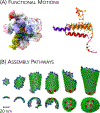Advances in coarse-grained modeling of macromolecular complexes
- PMID: 30508766
- PMCID: PMC6296860
- DOI: 10.1016/j.sbi.2018.11.005
Advances in coarse-grained modeling of macromolecular complexes
Abstract
Recent progress in coarse-grained (CG) molecular modeling and simulation has facilitated an influx of computational studies on biological macromolecules and their complexes. Given the large separation of length-scales and time-scales that dictate macromolecular biophysics, CG modeling and simulation are well-suited to bridge the microscopic and mesoscopic or macroscopic details observed from all-atom molecular simulations and experiments, respectively. In this review, we first summarize recent innovations in the development of CG models, which broadly include structure-based, knowledge-based, and dynamics-based approaches. We then discuss recent applications of different classes of CG models to explore various macromolecular complexes. Finally, we conclude with an outlook for the future in this ever-growing field of biomolecular modeling.
Copyright © 2018 Elsevier Ltd. All rights reserved.
Conflict of interest statement
Author Disclosures
The authors declare no conflict of interest.
Figures


Similar articles
-
Coarse-grained modeling for macromolecular chemistry.Top Curr Chem. 2012;307:295-321. doi: 10.1007/128_2010_122. Top Curr Chem. 2012. PMID: 21360319 Review.
-
Recent Advances in Coarse-Grained Models for Biomolecules and Their Applications.Int J Mol Sci. 2019 Aug 1;20(15):3774. doi: 10.3390/ijms20153774. Int J Mol Sci. 2019. PMID: 31375023 Free PMC article. Review.
-
Modeling Structural Dynamics of Biomolecular Complexes by Coarse-Grained Molecular Simulations.Acc Chem Res. 2015 Dec 15;48(12):3026-35. doi: 10.1021/acs.accounts.5b00338. Epub 2015 Nov 17. Acc Chem Res. 2015. PMID: 26575522 Review.
-
Recent advances in transferable coarse-grained modeling of proteins.Adv Protein Chem Struct Biol. 2014;96:143-80. doi: 10.1016/bs.apcsb.2014.06.005. Epub 2014 Aug 24. Adv Protein Chem Struct Biol. 2014. PMID: 25443957 Free PMC article. Review.
-
A novel multiscale scheme to accelerate atomistic simulations of bio-macromolecules by adaptively driving coarse-grained coordinates.J Chem Phys. 2020 Mar 21;152(11):114115. doi: 10.1063/1.5135309. J Chem Phys. 2020. PMID: 32199430
Cited by
-
Understanding insulin and its receptor from their three-dimensional structures.Mol Metab. 2021 Oct;52:101255. doi: 10.1016/j.molmet.2021.101255. Epub 2021 May 13. Mol Metab. 2021. PMID: 33992784 Free PMC article. Review.
-
Critical mechanistic features of HIV-1 viral capsid assembly.Sci Adv. 2023 Jan 6;9(1):eadd7434. doi: 10.1126/sciadv.add7434. Epub 2023 Jan 6. Sci Adv. 2023. PMID: 36608139 Free PMC article.
-
Evolving SAXS versatility: solution X-ray scattering for macromolecular architecture, functional landscapes, and integrative structural biology.Curr Opin Struct Biol. 2019 Oct;58:197-213. doi: 10.1016/j.sbi.2019.04.004. Epub 2019 Jun 13. Curr Opin Struct Biol. 2019. PMID: 31204190 Free PMC article. Review.
-
Challenges in protein docking.Curr Opin Struct Biol. 2020 Oct;64:160-165. doi: 10.1016/j.sbi.2020.07.001. Epub 2020 Aug 21. Curr Opin Struct Biol. 2020. PMID: 32836051 Free PMC article. Review.
-
Modeling DNA Opening in the Eukaryotic Transcription Initiation Complexes via Coarse-Grained Models.Front Mol Biosci. 2021 Nov 15;8:772486. doi: 10.3389/fmolb.2021.772486. eCollection 2021. Front Mol Biosci. 2021. PMID: 34869598 Free PMC article.
References
Publication types
MeSH terms
Substances
Grants and funding
LinkOut - more resources
Full Text Sources

